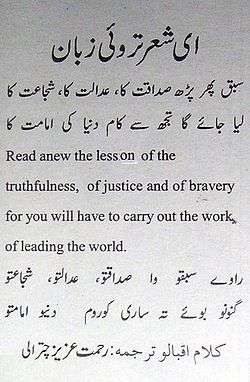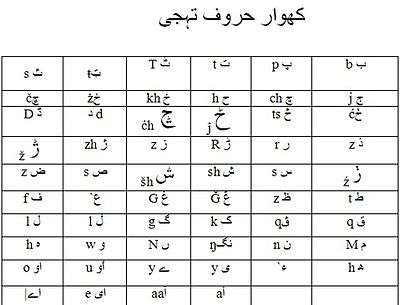Khowar alphabet
| Khowar | |
|---|---|
| Type |
Abjad
|
| Languages | Khowar, Balti, Burushaski, others |
Time period | early 20th century - present |
Parent systems | |
|
U+0600–U+06FF U+0750–U+077F | |
The Khowar alphabet is the right-to-left alphabet used for the Khowar language. It is a modification of the Urdu alphabet, which is itself a derivative of the Persian alphabet and Arabic alphabet. According to the Khowar Academy with 60 letters, the Khowar alphabet is typically written in the calligraphic Nasta'liq script, whereas Arabic is more commonly in the Naskh style. Usually, bare transliterations of Khowar into Roman letters omit many phonemic elements that have no equivalent in English or other languages commonly written in the Latin script. The Khowar Academy of Pakistan has developed a number of systems with specific notations to signify non-English sounds, but these can only be properly read by someone already familiar with Khowar, Persian, or Arabic for letters such as:ژ خ غ ط ص or ق and Hindi for letters such as ڑ.
History


The Khowar language developed during the rule of Mehtar of Chitral State.Since the early twentieth century Khowar has been written in the Khowar alphabet, which is based on the Urdu alphabet and uses the Nasta'liq script. Prior to that, the language was carried on through oral tradition. Today Urdu and English are the official languages and the only major literary usage of Khowar is in both poetry and prose composition. Khowar has also been occasionally written in a version of the Roman script called Roman Khowar since the 1960s. Despite the invention of the Khowar typewriter in 1996 by Rehmat Aziz Chitrali, Khowar newsletters and newspapers continued to be published from handwritten scripts by the Khowar authors until the late 1990s. The Montly Zhang is the first newsletter was the first Khowar newspaper to use Nasta’liq computer-based composition. There are efforts under way to develop more sophisticated and user-friendly Khowar support on computers and the internet. Nowadays, nearly all Khowar newspapers, magazines, journals, and periodicals are composed on computers via various Khowar software programs.
Nasta'liq
The Nasta'liq calligraphic writing style began as a Persian mixture of scripts Naskh and Ta'liq. Nasta'liq is more cursive and flowing than its Naskh counterpart.
Alphabet
A list of the letters of the Khowar alphabet and their pronunciation is given below. Khowar contains many historical spellings from Arabic and Persian, and therefore has many irregularities. The Arabic letters yaa and haa both have two variants in Khowar: one of the yaa variants is used at the ends of words for the sound [i], and one of the haa variants is used to indicate the aspirated consonants. The retroflex consonants needed to be added as well; this was accomplished by placing a superscript ط (to'e) above the corresponding dental consonants. Several letters which represent distinct consonants in Arabic are conflated in Persian, and this has carried over to Khowar. Some of the original Arabic letters are not used in Khowar. This is the list of the Khowar letters created by Rehmat Aziz Chitrali, giving the consonant pronunciation. Many of these letters also represent vowel sounds.
| Letter | Name of letter | Transcription | IPA |
|---|---|---|---|
| ا | alif | a | /a/ |
| ﺁ | alif long | aa | /aa/ |
| أ | alif hamza | a | /a/ |
| ب | be | b | /b/ |
| پ | pe | p | /p/ |
| ت | te | t | /t̪/ |
| ټ | te | t | /t̪/ |
| ٹ | ṭe | ṭ | /ʈ/ |
| ث | se | s | /s/ |
| ج | jīm | j | /d͡ʒ/ |
| چ | che | ch | /t͡ʃ/ |
| ح | baṛī he | h | /h/ |
| خ | khe | kh | /x/ |
| څ | tse | ts | /t͡s/ |
| ﺁ | dze | dze | /d͡z/ |
| ڇ | ce | e | /tʂ/ |
| ڂ | ce | ce | /dʐ/ |
| د | dāl | d | /d̪/ |
| ڈ | ḍāl | ḍ | /ɖ/ |
| ذ | zāl | dh | /z/ |
| ر | re | r | /r/ |
| ڑ | ṛe | ṛ | /ɽ/ |
| ز | ze | z | /z/ |
| ژ | zhe | zh | /ʒ/ |
| ݬ | zhe | ẓh | /ʐ/ |
| س | sīn | s | /s/ |
| ش | shīn | sh | /ʃ/ |
| ښ | shīn | ṣh | /ʂ/ |
| ص | su'ād | ṣ | /s/ |
| ض | zu'ād | z̤ | /z/ |
| ط | to'e | t | /t/ |
| ظ | zo'e | ẓ | /z/ |
| ع | ‘ain | ' | - |
| غ | ghain | gh | /ɣ/ |
| ڠ | gain | g | /ɣ/ |
| ف | fe | f | /f/ |
| ق | qāf | q | /q/ |
| ڨ | qif | q | /q/ |
| ك | kāf | k | /k/ |
| گ | gāf | g | /a/ |
| ل | lām | l | /l/ |
| ڵ | lām | l | /l/ |
| م | mīm | m | /m/ |
| ن | nūn | n | /n/ |
| ں | nūn | n | // |
| ݨ | ngūn | ng | /ŋ/ |
| ڼ | nūn | ṇ | /s/ |
| و | vā'o | v, o, or ū | /ʋ/, /oː/, /ɔ/ or /uː/ |
| ؤ | vā'o hamza | v, o, or ū | /ʋ/ |
| ۇ | vā'o pesh | v, o, or ū | /ʋ/ |
| ه | choṭī he | h | /h/ |
| ة | choṭī he with te | h | /h/ |
| ھ | do chashmī he | h | /ʰ/ |
| ء | hamza | ' | /ʔ/ |
| ي | ye | y, i | /j/ or /iː/ |
| ئ | ye hamza | y, i | /j/ or /iː/ |
| ى | khowar ye | y, i | /j/ or /iː/ |
| ے | bari ye | ai or e | /ɛː/, or /eː/ |
| ۓ | ye hamza | y, i | /j/ or /iː/ |
Vowels
Vowels in Khowar are represented by letters that are also considered consonants. Many vowel sounds can be represented by one letter. Confusion can arise, but context is usually enough to figure out the correct sound.
Vowel chart
This is a list of Khowar vowels found in the initial, medial, and final positions.
| Romanization | Pronunciation | Final | Medial | Initial |
|---|---|---|---|---|
| a | /ə/ | |||
| ā | /ɑː/ | |||
| i | /j/ | |||
| ī | /iː/ | |||
| u | /ʊ/ | |||
| ū | /uː/ | |||
| e | /eː/ | |||
| ai | /ɛ/ | |||
| o | /oː/ | |||
| au | /ɔ/ |
Short vowels
Short vowels ("a", "i", "u") are represented by marks above and below a consonant.
| Vowel | Name | Transcription | IPA |
| بَ | zabar | ba | /ə/ |
| بِ | zer | bi | /j/ |
| بُ | pesh | bu | /ʊ/ |
Alif
Alif (ا) is the first letter of the Khowar alphabet, and it is used exclusively as a vowel. At the beginning of a word, alif can be used to represent any of the short vowels, e.g. ابدار abdar, اسم ism, اردو Urdu. Also at the beginning, an alif (ا) followed by either wā'o (و) or ye (ی) represents a long vowel sound. However, wā'o (و) or ye (ی) alone at the beginning represents a consonant.
Alif also has a variant, call alif madd (آ). It is used to represent a long "ā" at the beginning of a word, e.g. آپک āpak, آدیمزاد ādmzaad. At the middle or end of a word, long ā is represented simply by alif (ا), e.g. باغ bāgh, آرام ārām.
Wā'o
Wā'o is used to render the vowels "ū", "o", and "au". It also renders the consonants "w" and 'v', but many people get confused between these two sounds.
Ye
Ye is divided into two variants: choṭī ye and baṛi ye.
Choṭī ye (ی) is written in all forms exactly as in Persian. It is used for the long vowel "ī" and the consonant "y".
Baṛī ye (ے) is used to render the vowels "e" and "ai" (/eː/ and /æː/ respectively). Baṛī ye is distinguished in writing from choṭī ye only when it comes at the end of a word.
Use of specific letters
Retroflex letters
Retroflex consonants were not present in the Persian alphabet, and therefore had to be created specifically for Khowar. This was accomplished by placing a superscript ط (to'e) above the corresponding dental consonants.[1]
| Letter | Name | IPA |
| ٹ | ṭe | [ʈ] |
| ڈ | ḍāl | [ɖ] |
| ڑ | aṛ | [ɽ] |
Do chashmī he
The letter do chashmī he (ھ) is used in native Hindustānī words, for aspiration of certain consonants. The aspirated consonants are sometimes classified as separate letters, although it takes two characters to represent them.
| Transcription | IPA | |
| بھ | bhe | [bʱ ː] |
| پھ | phe | [pʰ ː] |
| تھ | the | [t̪ʰ ː] |
| ٹھ | ṭhe | [ʈʰ ː] |
| جھ | jhe | [d͡ʒʱeː] |
| چھ | che | [t͡ʃʰeː] |
| دھ | dhe | [dʱ ː] |
| ڈھ | ḍhe | [ɖʱ ː] |
| ڑھ | ṛhe | [ɽʱeː] |
| کھ | khe | [kʰeː] |
| گھ | ghe | [ɡʱeː] |
References
- ↑ Bashir, Elena; Hussain, Sarmad; Anderson, Deborah (2006-05-05). "N3117: Proposal to add characters needed for Khowar, Torwali, and Burushaski" (PDF). ISO/IEC JTC1/SC2/WG2.